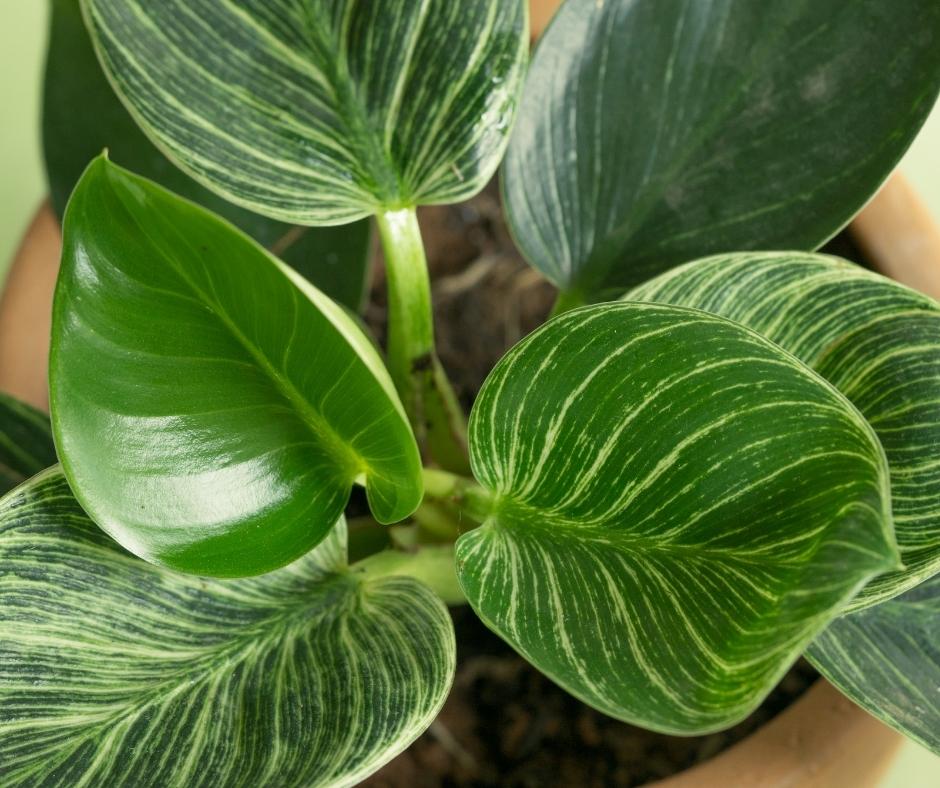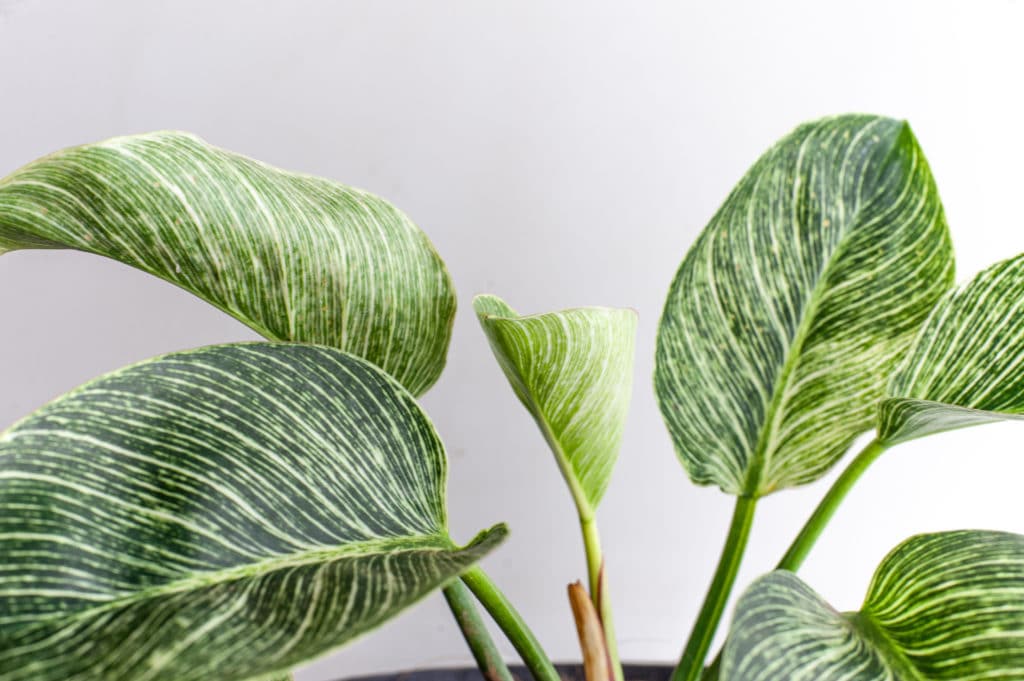
If you know what to do, propagating your Philodendron Birkin is not difficult. As a result, we hope that this post will walk you through the process step-by-step!
Philodendron Birkins may be difficult to find in plant shops, therefore propagation is the most effective method to increase your Birkin plant. These beautiful white striped plants are simple to care for and offer a unique touch to your home.
Having a groovy philodendron plant like the Philodendron Birkin is fun, but it might be more difficult than you think. So we hope this article will walk you through the whole process from beginning to end, including everything you’ll need and how to avoid common mistakes and get the most out of your Philodendron Birkin.
How to propagate Philodendron Birkin
There are several good reasons to start your own Philodendron Birkin. The most popular reason is that you just want to expand the number of plants without having to purchase any more. Who can refuse free plants? Plant cuttings are also fantastic presents for friends, especially when it’s difficult for them to obtain their own Philodendron Birkin.
Another common reason for many plant parents to propagate their plants is because they are either getting too large or excessively leggy. Cutting your plant back encourages bushier development and is an excellent method to prune that winter growth, which may have become straggly or leggy. Why not instead of simply discarding the cuttings, propagate them in order to start a whole new mother plant?
What tools are needed to propagate a Philodendron Birkin?
Let’s start with the easy part. Before you make your first cut, it’s crucial to ensure that you have everything necessary!
- Healthy and mature Philodendron Birkin
- Sharp scissors/shears
- Spare pot(s)
- Fresh soil mix and water
- Newspaper or plastic sheet
- Toothpick, plastic wrap, and peat moss (if you are using the air layering method)

How can I propagate my Philodendron Birkin?
Philodendron Birkins may be propagated in three ways: stem cuttings, division, and layering. The most frequent propagation techniques for Philodendron Birkins are stem cuttings and division, which we recommend if you’re just getting started with growing houseplants. Each process is detailed below in a step-by-step format.
Stem cutting method
- 1
- Locate your stem cutting
- When taking a stem cutting, you must ensure that the section of the plant you are pruning is in good condition, since this will affect the success of your endeavor. You must also confirm that there is at least one node in this portion of your Philodendron Birkin. This is a stem joint where roots would emerge from if possible. If possible, select a region of the plant with aerial roots; it means it will be a more mature plant and propagation will be faster.
- 2
- Make the cut
- You should not cut your plant with unclean scissors/ shears/ or a knife since this would send dirt and germs to the plant. Make a clean cut across your plant at an angle using your equipment. This exposes more surface area of the cutting.
- 3
- Take off any lower leaves
- As you will be storing your cutting in water for an extended period of time, it’s crucial to remove any leaves from the lower portion of the cutting that may fall into the water. They will decay if kept in water for a long time, so it’s best to get rid of them now.
- 4
- Fill up your container with water
- Fill a glass halfway with fresh temperate water to set your Philodendron Birkin chop in. Make sure the water isn’t excessively cold or hot, as this may shock or burn the cutting and cause it to die. It’s preferable to use purified water for this reason, as well as because the chlorine and fluoride levels might be higher than in regular tap water. Filtered water or rainwater are other options.
- 5
- Place your cuttings in water
- Make sure the nodes on the stem cutting are in water so that the roots can emerge from them. Place your glass in bright, but shaded light. Extreme light will damage the cutting and prevent a successful propagation. You may use an LED grow light to determine if Philodendron Birkin cuttings are receiving enough sunshine. Adding more lighting is also possible by utilizing an LED grow light, which is ideal for encouraging growth in cuttings. We adore this one, which you can get on Amazon here.
- At this stage, you may choose to apply rooting hormone. This will aid in the development of new cuttings’ roots. We’ve found that this rooting gel is very effective; it’s available on Amazon here.
- 6
- Change the water regularly
- It’s critical to keep the water in your propagation station fresh, so we recommend changing it every two days. This prevents bacteria from growing and producing an unpleasant odor.
- 7
- Plant your cuttings in a container of potting soil.
You can put your Philodendron Birkin cutting into the soil when its roots are longer than a few centimeters. To help drainage and aeration, we recommend using a high-quality potting mix. This Miracle Gro potting mix is our top choice for soil. Place your cutting carefully in the mixture without damaging the fragile newly formed roots, then continue to maintain your Philodendron Birkin as usual.
Method 2: Division
You must use this approach if your Philodendron Birkin has numerous offshoots growing from the same mother plant. If your plant is just one offshoot, you must utilize stem cutting or layering techniques.
- 1
- Locate the various offshoots
- If your Philodendron Birkin has several offshoots, it will become clear which part to split it. They’ll be completely separate, with growth originating from the middle of each section.
- 2
- Take the plant out of the pot
- You’ll need to extricate the Philodendron Birkin from the pot and divide the root system after you’ve discovered the plant’s various parts. Gently remove the plant from its container and shake off the dirt around the roots. To loosen the earth, run your hands through the roots to start to separate them.
- 3
- Separate the sections
- If you’re unable to detangle the hair easily, you may need to trim away any persistent roots. However, if you can carefully pull the sections apart from one another, you should be fine. If you must slice around the plant to separate it, don’t worry; just make sure each piece has a significant amount of root system to help with propagation. Always use shears to split plants instead of pulling them apart since this is much more durable!
- 4
- Place in water or fresh potting mix
- After the potting mix has dried, transplant the mother plant back inside its original container and see whether you want to put the offshoot in water first or straight into potting soil. This is determined by the size of the cutting and the health of the root system. If your cut has well-developed roots that are ready to be planted in potting mix, there’s no need to worry about it. However, if you think the roots require a little more time to develop before being placed in water as a middle step, that’s fine as well.
- 5
- Continue normal care
If you’re cutting a Philodendron Birkin, clean it and repot it as you would any other Philodendron Birkin. If your plant is in water first, change the water every few days and once the roots have developed a little, repot into the potting mix.
Method 3: Air layering
It is definitely worth attempting, yet it can be a little more difficult and fiddly. We only suggest it to more experienced plant breeders!
- 1
- Locate a healthy stem
- You must choose the air layering technology carefully. Make sure you’re using a viable, healthy, and robust portion of the stem.
- 2
- Make a vertical incision into the stem
- Make a deep vertical cut with the clean knife into the stem for about a couple of inches long. It should go halfway through the stem.
- 3
- Open up the incision
- To keep the incision from closing, insert a toothpick into the center of it.
- 4
- Attach damp peat moss to the side of the incision
- Tying the peat moss around the stem with the cutting in place, making sure it remains damp but not soggy at all times, is essential.
- 5
- Wrap up the peat moss
- To keep the peat moss and stem secure, wrap a layer of plastic wrap around them.
- 6
- After you’ve identified a new root, you can easily cut it off.
When you remove the film, the roots should be visible. When this happens, slice off a piece of the main plant, remove the layer covering it, and repot it in fresh potting soil. The new roots will be delicate and easily destroyed; handle them with care.

Philodendron Birkin Propagation FAQs
Here are a few of the most frequent questions we receive when individuals want to propagate their Philodendron Birkin.
What’s the best time of year to propagate a Philodendron Birkin?
For the best chance of successful propagation, you should try to propagate in the springtime. Make sure that any previous winter conditions have passed so that your cuttings may develop in warmer, more light-filled months.
If you choose to start your cutting in the fall or winter, it will be attempting to develop in the dormant season, and little progress will be made. This raises the potential of root or leaf rot, which can kill your cuttings. Spring is a season when there are many months of sunshine and a warm environment, encouraging new roots and leaves to emerge. The stress of propagation can be greatly reduced by wrapping the mother plant in a cloth. It will also help the plant recover more quickly from the shock of reproduction. If you want to propagate in colder temperatures and darker months, using a heating pad and LED grow lights are an excellent method to assist it to thrive.
Do I need to use a rooting gel or powder?
While it is not necessary, you may wish to apply rooting gels or powders to enhance propagation success. Root hormone solutions encourage new cutting development and not only speed up the process but also improve the roots.
There are three types of rooting hormone: powder, liquid, and gel. You dip the cutting into water first before sprinkling it with powder. The moisture aids in the adhesion of the powder to the cutting. Only a small portion of the Cutting should be covered. Work similarly to gel and liquid forms, but are ideal for propagation in water first. This rooting gel is available on Amazon and is highly recommended.
It is not necessary to apply rooting hormones because they might cause too much development, which will damage the plant and actually slow down the growth process. For optimum outcomes, use cautiously and sparingly.
Can I use a grow light for my Philodendron Birkin cuttings?
Grow lights are ideal for growing houseplants since they provide optimum bright light conditions for young seeds and cuts. They may help to prevent problems caused by a lack of sunshine while also promoting growth. Grow lights are also beneficial in numerous ways, such as using them on your houseplants if they don’t get enough light in the fall and winter seasons, making them an excellent investment for any plant parent. This is a fantastic product from Amazon that we’ve used many times with our Philodendron Birkin cuttings and it always works wonderfully.
Why is it important to use clean tools when propagating?
It’s critical to clean your instruments before and after coming into touch with a plant to prevent any cross-contamination between your plants. Scissors and shears may transport pests and illnesses from one plant to the next that you aren’t aware of.
Another important benefit of cleaning your equipment after coming into contact with a plant is that many houseplants are poisonous, including the Philodendron Birkin. As a result, you should make sure there is no evidence of the plant on your tools so that others who use them are not harmed.
What is a node?
It’s critical to be able to tell the difference between different aspects of the plant so you know where to make the incision. A node is where the stem and leaf joints come together. Aerial roots will grow from these nodes on Philodendron Birkin plants frequently. If there isn’t a root yet, you may detect a small bump in the stem that indicates a node.
Can I propagate a Philodendron Birkin from a single leaf?
Unfortunately, you cannot grow Philodendron Birkin plants from a single leaf cutting. There must be at least one node in order for roots to develop.
Do I need to fertilize my Philodendron Birkin cuttings?
We never suggest fertilizing cuttings until they are a year old or older. It can hinder new root development because you are delivering nutrients straight to the plant. Fertilizing such young plants may also shock them and induce problems including yellow leaf and stunted growth, so wait a while before feeding them.
After a year, you’ll want to start feeding your new plant with liquid fertilizer, since you can easily vary how much you’re fertilizing it when compared to plant food spikes.
Common problems when propagating a Philodendron Birkin plant
Many factors influence the success of plant propagation, and you may encounter difficulties while trying to grow them. But don’t worry, we’ve compiled a list of what causes these issues and how to fix them before they kill your growing cuttings.
Why aren’t my cuttings developing roots?
Philodendron Birkin plants are difficult to grow and may take months or even years for new roots to appear. If you replace the water regularly and maintain the plant in a warm environment, new roots should emerge over time. You can use rooting gel to speed up growth, but it won’t always deliver the outcomes you desire.
If you’re attempting to grow indoors when the weather isn’t particularly hot, this might be the reason for your lack of development. By using a heating pad placed beneath your cuttings, you can aid in the growth of roots. This warms up the region and creates an ideal climate for new growth.
Why has my cutting become gummy?
If your cutting is turning brown and mushy, it’s a terrible sign. This is typically because the cutting has rotted in stagnant water. You should make sure to refresh the water (every other day) so that germs don’t grow. Trimming away the putrid portions of the cutting and hoping for a recovery may help it grow roots.
Why are the new leaves on my cutting so tiny?
If your cutting’s new leaves are getting bigger and larger but they’re smaller than the mother plant’s, don’t worry. This is completely natural and simply because the root structure is less developed than that of the larger plant. Give it time and if your plant gets enough bright light, the new leaves will get larger over time, allowing you to remove the smaller leaves to stimulate new healthy growth.
An LED grow light can assist expansion a little by ensuring that your new plant is in the correct setting. This one from Amazon has worked really well on new cuttings and plants, according to our tests.
Why is my Philodendron Birkin cutting turning yellow?
If the Philodendron Birkin leaves on your cutting are yellowing as a result of too much direct sunshine, it’s possible that they have been scorched or burned. It’s also possible that your plant is receiving inadequate light, so check the environment in which it is grown. Using a light monitor can assist you to determine how much light your plant receives throughout the day.
Another possibility is root rot, which might be caused by a variety of factors. Examine your plants’ roots carefully if this is the case. If you’ve just transplanted your cutting from water to potting mix, remove it from the container and check for issues with the roots.
A moisture meter is one way we ensure that our cuttings get enough water. Simply place them in the moist soil and they’ll take care of themselves!
Do you have a strange film on your cuttings in water?
It’s quite common for a strange layer to form around your cutting and roots in water. This is completely natural and should not be considered a problem. To wash away this layer, rinse your cutting every time you switch out the water.
Final Thoughts
We hope you found this comprehensive Philodendron Birkin propagation guide useful. It’s never a perfect science, and some cutting roots will take longer to grow than others, or they won’t work for no apparent reason. However, with the appropriate procedures, care, and setting, you should be able to succeed. We’ve had to wait months for our cuttings’ roots to develop before; therefore it’s kind of like a waiting game. But the end result is well worth the wait!
Visit our complete Philodendron Birkin Care Guide to discover all of the information you need on how to maintain your cuttings once they’ve developed.
